A High Andean Lake: A Current Look at Anthropogenic Activities and Water Quality
Abstract
1. Introduction
2. Materials and Methods
2.1. Study Area
2.2. Water Sample Collection
2.3. Water Quality Parameter Measurements
2.4. Water Quality Index (WQI-PE) Determination
2.5. Chlorophyll Determination
2.6. Trophic State Index (TE) Calculation
2.7. Evaluation of Environmental Impacts in the Lake
2.8. Data Analysis Techniques
3. Results and Discussion
3.1. Analysis of the Physical and Chemical Parameters of the Lake Water
| Season | SD | Tu | TDS | EC | AC | pH | DO | NH4 | NO2− | NO3− | PT | Chlo | TE | WQI-PE | ||
|---|---|---|---|---|---|---|---|---|---|---|---|---|---|---|---|---|
| Surface | Dry | Max | 4.81 | 2.90 | 92.06 | 183.50 | <DL | 7.90 | 5.39 | 1.18 | <DL | <DL | <DL | 6.68 | 44.83 | 59.37 |
| Min | 3.61 | 1.60 | 86.38 | 171.63 | 7.30 | 4.80 | 0.13 | 1.25 | 39.79 | 55.26 | ||||||
| 4.26 | 1.94 | 89.57 | 179.82 | 7.73 | 5.13 | 0.57 | 3.74 | 42.57 | 57.47 | |||||||
| s (±) | 0.43 | 0.48 | 2.23 | 4.61 | 0.22 | 0.22 | 0.42 | 2.12 | 2.07 | 1.64 | ||||||
| CV | 9.97 | 24.99 | 2.50 | 2.56 | 2.86 | 4.29 | 73.132 | 56.7 | 4.86 | 2.86 | ||||||
| Rain | Max | 3.81 | 11.87 | 35.59 | 98.60 | 25.33 | 8.79 | 6.08 | <DL | <DL | <DL | <DL | 25.28 | 52.13 | 53.73 | |
| Min | 2.61 | 3.43 | 13.81 | 35.33 | 15.67 | 8.45 | 5.22 | 8.99 | 47.10 | 50.77 | ||||||
| 3.00 | 6.18 | 21.10 | 72.55 | 19.67 | 8.59 | 5.71 | 18.05 | 49.85 | 52.52 | |||||||
| s (±) | 0.49 | 3.48 | 7.53 | 23.85 | 3.55 | 0.15 | 0.34 | 7.02 | 2.08 | 1.17 | ||||||
| CV | 16.17 | 56.28 | 35.71 | 32.87 | 18.06 | 1.71 | 5.89 | 38.90 | 4.17 | 2.23 | ||||||
| Bottom | Dry | Max | 4.81 | 2.57 | 92.20 | 184.50 | 7.00 | 7.71 | 5.65 | 2.30 | <DL | <DL | <DL | 6.23 | 44.83 | 60.34 |
| Min | 3.61 | 1.30 | 86.59 | 174.13 | 1.00 | 7.60 | 4.83 | 0.27 | 0.89 | 39.79 | 54.17 | |||||
| 4.26 | 1.66 | 90.18 | 181.11 | 3.28 | 7.67 | 5.24 | 0.90 | 3.00 | 42.57 | 56.66 | ||||||
| s (±) | 0.43 | 0.47 | 2.06 | 3.78 | 2.78 | 0.05 | 0.30 | 0.76 | 1.99 | 2.07 | 2.18 | |||||
| CV | 9.97 | 28.31 | 2.29 | 2.09 | 84.94 | 0.61 | 5.74 | 84.42 | 66.44 | 4.86 | 3.85 | |||||
| Rain | Max | 3.81 | 10.90 | 41.97 | 107.05 | 29.67 | 8.66 | 6.08 | 0.09 | <DL | <DL | <DL | 23.85 | 52.13 | 52.80 | |
| Min | 2.61 | 3.33 | 12.64 | 63.72 | 18.00 | 7.72 | 5.30 | 0.01 | 7.83 | 47.10 | 50.32 | |||||
| 3.00 | 5.70 | 21.37 | 87.88 | 22.94 | 8.42 | 5.73 | 0.03 | 16.47 | 49.85 | 51.75 | ||||||
| s (±) | 0.49 | 3.17 | 10.92 | 15.16 | 4.39 | 0.36 | 0.30 | 0.03 | 6.89 | 2.08 | 0.84 | |||||
| CV | 16.17 | 55.61 | 51.10 | 17.25 | 19.13 | 4.29 | 5.28 | 125.0 | 41.83 | 4.17 | 1.61 | |||||
| DL | --- | 0.10 | 1.00 | 1.00 | 1.00 | 0.01 | 0.10 | 0.01 | 0.001 | 0.10 | 0.01 | --- | Mesotrophic | Regular | ||
| ECA | --- | 100 | 1000 | 1000 | 20.0 | 6.5 | 5.0 | 2.2 | 10.0 | 13.0 | 0.035 | 8.00 | ||||
| Category * | --- | 1.B | 1.B | 4 | 4 | 4 | 4 | 4 | 3.D2 | 4 | 4 | 4 | ||||
| Season | Metal Ion | Mineral Ion | Heavy Metal Ion | ||||||||||||||||
|---|---|---|---|---|---|---|---|---|---|---|---|---|---|---|---|---|---|---|---|
| Al | Cu | Ba | Be | Mn | V | Ca | Mg | K | Na | Si | As | B | Pb | Sb | Se | Tl | |||
| Surface | Dry | Max | 0.195 | 0.016 | 0.013 | 0.002 | 0.141 | 0.013 | 15.81 | 2.70 | 1.357 | 2.789 | 0.714 | 0.161 | 0.030 | 0.050 | 0.140 | 0.160 | 0.021 |
| Min | 0.168 | 0.011 | 0.010 | 0.001 | 0.134 | 0.006 | 14.90 | 2.49 | 1.235 | 2.386 | 0.152 | 0.141 | 0.025 | 0.043 | 0.113 | 0.127 | 0.009 | ||
| 0.178 | 0.013 | 0.012 | 0.002 | 0.137 | 0.009 | 15.29 | 2.63 | 1.290 | 2.514 | 0.375 | 0.149 | 0.027 | 0.048 | 0.126 | 0.143 | 0.014 | |||
| s (±) | 0.010 | 0.002 | 0.001 | 0.001 | 0.003 | 0.003 | 0.35 | 0.09 | 0.048 | 0.156 | 0.235 | 0.007 | 0.002 | 0.003 | 0.009 | 0.012 | 0.005 | ||
| CV | 5.39 | 13.69 | 9.30 | 31.46 | 1.90 | 27.29 | 2.29 | 3.26 | 3.69 | 6.19 | 62.62 | 4.78 | 6.058 | 5.696 | 7.174 | 8.056 | 38.66 | ||
| Rain | Max | 1.135 | 0.023 | 0.194 | <DL | 0.298 | 0.010 | 41.34 | 9.63 | 4.713 | 6.200 | 1.344 | 0.298 | 0.046 | 0.077 | 0.280 | 0.283 | 0.035 | |
| Min | 0.464 | 0.016 | 0.052 | 0.266 | 0.008 | 38.97 | 9.17 | 4.291 | 5.892 | 0.950 | 0.262 | 0.040 | 0.063 | 0.240 | 0.257 | 0.004 | |||
| 0.581 | 0.020 | 0.077 | 0.284 | 0.009 | 40.13 | 9.33 | 4.473 | 6.028 | 1.143 | 0.279 | 0.042 | 0.073 | 0.258 | 0.267 | 0.018 | ||||
| s (±) | 0.271 | 0.003 | 0.057 | 0.012 | 0.001 | 0.913 | 0.17 | 0.151 | 0.126 | 0.139 | 0.013 | 0.002 | 0.005 | 0.013 | 0.009 | 0.011 | |||
| CV | 46.69 | 15.03 | 73.86 | 4.19 | 10.97 | 2.27 | 1.77 | 3.38 | 2.08 | 12.18 | 4.55 | 4.734 | 6.742 | 5.019 | 3.446 | 63.54 | |||
| Bottom | Dry | Max | 0.189 | 0.015 | 0.013 | 0.002 | 0.138 | 0.012 | 15.34 | 2.67 | 1.338 | 2.723 | 0.733 | 0.161 | 0.033 | 0.063 | 0.145 | 0.168 | 0.025 |
| Min | 0.169 | 0.013 | 0.010 | 0.001 | 0.132 | 0.007 | 14.98 | 2.54 | 1.228 | 2.149 | 0.207 | 0.146 | 0.027 | 0.053 | 0.133 | 0.132 | 0.003 | ||
| 0.181 | 0.014 | 0.012 | 0.002 | 0.135 | 0.010 | 15.19 | 2.62 | 1.298 | 2.408 | 0.485 | 0.152 | 0.029 | 0.057 | 0.138 | 0.150 | 0.014 | |||
| s (±) | 0.007 | 0.001 | 0.001 | 0.001 | 0.003 | 0.002 | 0.157 | 0.06 | 0.039 | 0.228 | 0.184 | 0.006 | 0.002 | 0.004 | 0.004 | 0.015 | 0.008 | ||
| CV | 4.07 | 7.38 | 6.44 | 33.28 | 2.01 | 21.91 | 1.04 | 2.17 | 3.00 | 9.45 | 37.91 | 4.14 | 6.59 | 6.81 | 3.08 | 10.30 | 58.56 | ||
| Rain | Max | 1.622 | 0.021 | 0.205 | <DL | 0.285 | 0.012 | 40.61 | 9.65 | 4.558 | 6.151 | 1.397 | 0.289 | 0.044 | 0.077 | 0.273 | 0.287 | 0.040 | |
| Min | 0.455 | 0.017 | 0.053 | 0.273 | 0.007 | 39.08 | 9.13 | 4.411 | 5.853 | 0.955 | 0.270 | 0.040 | 0.067 | 0.240 | 0.250 | 0.014 | |||
| 0.661 | 0.019 | 0.079 | 0.278 | 0.010 | 39.92 | 9.31 | 4.485 | 6.015 | 1.151 | 0.279 | 0.042 | 0.070 | 0.259 | 0.273 | 0.025 | ||||
| s (±) | 0.471 | 0.001 | 0.061 | 0.004 | 0.002 | 0.599 | 0.20 | 0.051 | 0.117 | 0.146 | 0.006 | 0.001 | 0.004 | 0.014 | 0.012 | 0.009 | |||
| CV | 71.33 | 6.80 | 77.26 | 1.44 | 19.69 | 1.50 | 2.16 | 1.14 | 1.95 | 12.69 | 2.25 | 2.93 | 5.22 | 5.44 | 4.53 | 37.19 | |||
| DL | 0.010 | 0.001 | 0.001 | 0.001 | 0.001 | 0.001 | 0.001 | 0.001 | 0.001 | 0.001 | 0.001 | 0.010 | 0.001 | 0.010 | 0.010 | 0.010 | 0.010 | ||
| ECA | 5.00 | 0.10 | 0.70 | 0.10 | 0.20 | 0.10 | --- | 250.0 | --- | --- | --- | 0.150 | 0.75 | 0.003 | 0.640 | 0.005 | 0.001 | ||
| Category * | 3.D2 | 4 | 4 | 3.D2 | 3.D2 | 1.B | --- | 3.D2 | --- | --- | --- | 4 | 2.C4 | 4 | 4 | 4 | 4 | ||
3.2. Analysis of Metal Ions in the Water
3.3. Trophic State (TE) and Quality Index (WQI-PE)
3.4. Multivariate Data Analysis
3.5. Analysis of the Magnitude of Impacts of Anthropogenic Activities on Pacucha Lagoon
4. Conclusions
Author Contributions
Funding
Data Availability Statement
Acknowledgments
Conflicts of Interest
References
- Li, P.; Wu, J. Water Resources and Sustainable Development. Water 2023, 16, 134. [Google Scholar] [CrossRef]
- Leitão, M.F.; Cunha, A.; Ferreira, M.M. Water-Education as a Promoter of Education for Sustainable Development: Three Studies in Portuguese-Speaking African Countries. Eur. J. Sustain. Dev. 2020, 9, 192. [Google Scholar] [CrossRef]
- Nagabhatla, N.; Avellán, T.; Pouramin, P.; Qadir, M.; Mehta, P.; Payne, J.; Stefan, C.; Hülsmann, S.; Abrate, T.; Teruggi, G.; et al. Chapter 2: Physical and environmental dimensions. In The United Nations World Water Development Report 2019: Leaving No One Behind; UNESCO: Paris, France, 2019; pp. 1–201. [Google Scholar]
- Preisner, M. Water: The Most Undervalued Resource on Earth. Environ. Res. Eng. Manag. 2022, 78, 5. [Google Scholar] [CrossRef]
- Jahura, S.; Islam, M.S.; Mostafa, M.G. Impact of water scarcity on rural livelihood in the drought-prone region: A review of global perspectives. Indones. J. Soc. Sci. 2024, 16, 1–13. [Google Scholar] [CrossRef]
- OECD. Organisation for Economic, Co-Operation Development. Eutrophication of Waters: Monitoring, Assessment and Control; Final Report; OECD: Paris, France, 1982; p. 154. [Google Scholar]
- Cloutier, R.G.; Sanchez, M. Trophic status evaluation for 154 lakes in Quebec, Canada: Monitoring and recommendations. Water Qual. Res. J. 2007, 42, 252–268. [Google Scholar] [CrossRef]
- Allende, L.; Fontanarrosa, M.S. Addressing the trophic status in urban ponds: An evaluation of current trophic state indexes. Austral Ecol. 2023, 48, 1828–1847. [Google Scholar] [CrossRef]
- Romero-Mariscal, G.; Garcia-Chevesich, P.A.; Morales-Paredes, L.; Arenazas-Rodriguez, A.; Ticona-Quea, J.; Vanzin, G.; Sharp, J.O. Peruvian Wetlands: National Survey, Diagnosis, and Further Steps toward Their Protection. Sustainability 2023, 15, 8255. [Google Scholar] [CrossRef]
- Guevara-Pérez, E. Planning of applied research in water development projects in Peru. Int. J. Hydrol. 2018, 2, 266–276. [Google Scholar]
- Maldonado-Fonkén, M.; Chuquillanqui, H.; Vildoso, B.; Linares-Palomino, R. Plant communities of high-Andean bofedal wetlands across a trans-Andean transect in southern Peru. Veg. Classif. Surv. 2024, 5, 203–218. [Google Scholar] [CrossRef]
- ANA. National Protocol for the Monitoring of Surface Water Resources Quality; Autoridad Nacional del Agua, Ministerio de Desarrollo Agrario y Riego: Lima, Perú, 2016. [Google Scholar]
- Eaton, A.D.; Greenberg, A.E.; Clesceri, L.S.; Franson, M. Standard Methods for the Examination of Water and Wastewater, 23rd ed.; American Public Health Association: Washington, DC, USA, 2017. [Google Scholar]
- ANA. Methodology for Determining the ICA-PE Water Quality Index Applied to Surface Continental Water Bodies; Autoridad Nacional del Agua, Ministerio de Desarrollo Agrario y Riego: Lima, Perú, 2018. [Google Scholar]
- MINAM. Estándares de Calidad Ambiental (ECA) Para Agua. Decreto Supremo N° 004-2017-MINAM; Ministerio del Ambiente: Lima, Perú, 2017. [Google Scholar]
- Carlson, R.E. A trophic state index for lakes 1. Limnol. Oceanogr. 1977, 22, 361–369. [Google Scholar] [CrossRef]
- Clark, B.D.; Gilad, A.; Bisset, R.; Tomlinson, P. Perspectives on Environmental Impact Assessment: Proceedings of the Annual WHO Training Courses on Environmental Impact Assessment, Centre for Environmental Management and Planning, University of Aberdeen, Scotland, 1980–1983; Springer Science & Business Media: Berlin/Heidelberg, Germany, 2012. [Google Scholar]
- Abbas, M.D.; Al-Kasser, M.K. The Environmental Impact Assessment of the Spent Engine Oil Recycling Plant by using Leopold Matrix: Case Study Recycling Plant in Al-Diwaniyah City–Iraq. Al-Qadisiyah J. Pure Sci. 2021, 26, 221–230. [Google Scholar] [CrossRef]
- Leopold, L.B. A Procedure for Evaluating Environmental Impact; Department of the Interior: Washington, DC, USA, 1971; p. 645. [Google Scholar]
- Çako, V.; Zhuri, E.; Babani, F.; Karaja, T. Water Transparency as One as of Trophic State Indices in Narta Lagoon. IOSR J. Eng 2014, 4, 15–22. [Google Scholar] [CrossRef]
- Kader, S.; Raimi, M.O.; Spalevic, V.; Iyingiala, A.-A.; Bukola, R.W.; Jaufer, L.; Butt, T.E. A concise study on essential parameters for the sustainability of Lagoon waters in terms of scientific literature. Turk. J. Agric. For. 2023, 47, 288–307. [Google Scholar] [CrossRef]
- Kpidi, Y.H.; Koné, M.G.-R.; Ballet, T.G.N.; Ouattara, L.; Yapo, O.B.; Ziao, N. Modeling of the Dynamics and Prediction of Transparency of a Meotropic Tropical Lake: Bakré Lake (Abidjan, Côte d’Ivoire). Resour. Environ. 2018, 8, 174–183. [Google Scholar]
- Caballero, C.B.; Guedes, H.A.S.; Fraga, R.d.S.; Mendes, K.G.P.; Fonseca, E.H.d.; Martins, V.S.; Mensch, M.d.S. Predictive model for monitoring water turbidity in a subtropical lagoon using Sentinel-2A/B MSI images. RBRH 2023, 28, e5. [Google Scholar] [CrossRef]
- Çako, V.; Baci, S.; Shena, M. Water turbidity as one of the trophic state indices in Butrinti Lake. J. Water Resour. Prot. 2013, 05, 1144–1148. [Google Scholar] [CrossRef]
- Specchiulli, A.; Cilenti, L.; D’Adamo, R.; Fabbrocini, A.; Guo, W.; Huang, L.; Lugliè, A.; Padedda, B.M.; Scirocco, T.; Magni, P. Dissolved organic matter dynamics in Mediterranean lagoons: The relationship between DOC and CDOM. Mar. Chem. 2018, 202, 37–48. [Google Scholar] [CrossRef]
- Lebret, K.; Langenheder, S.; Colinas, N.; Östman, Ö.; Lindström, E.S. Increased water colour affects freshwater plankton communities in a mesocosm study. Aquat. Microb. Ecol. 2018, 81, 1–17. [Google Scholar] [CrossRef]
- Boyd, C.E. Water quality protection. In Water Quality: An Introduction; Springer: Cham, Switzerland, 2020; pp. 379–409. [Google Scholar]
- Adjovu, G.E.; Stephen, H.; James, D.; Ahmad, S. Measurement of total dissolved solids and total suspended solids in water systems: A review of the issues, conventional, and remote sensing techniques. Remote Sens. 2023, 15, 3534. [Google Scholar] [CrossRef]
- Maansi; Jindal, R.; Wats, M. Evaluation of surface water quality using water quality indices (WQIs) in Lake Sukhna, Chandigarh, India. Appl. Water Sci. 2022, 12, 1–14. [Google Scholar] [CrossRef]
- Ramos-Pacheco, B.S.; Choque-Quispe, D.; Ligarda-Samanez, C.A.; Solano-Reynoso, A.M.; Choque-Quispe, Y.; Aguirre Landa, J.P.; Agreda Cerna, H.W.; Palomino-Rincón, H.; Taipe-Pardo, F.; Zamalloa-Puma, M.M. Water Pollution Indexes Proposal for a High Andean River Using Multivariate Statistics: Case of Chumbao River, Andahuaylas, Apurímac. Water 2023, 15, 2662. [Google Scholar] [CrossRef]
- Blanchard, D.; Aherne, J.; Makar, P. Dissolved Organic Carbon in Lakes of the Athabasca Oil Sands Region: Is Color an Indicator of Acid Sensitivity? Environ. Sci. Technol. 2021, 55, 6791–6803. [Google Scholar] [CrossRef]
- Wang, J.; Fu, Z.; Qiao, H.; Liu, F. Assessment of eutrophication and water quality in the estuarine area of Lake Wuli, Lake Taihu, China. Sci. Total Environ. 2019, 650, 1392–1402. [Google Scholar] [CrossRef]
- Liu, J.; Zhang, C.; An, D.; Wei, Y. Development and application of an innovative dissolved oxygen prediction fusion model. Comput. Electron. Agric. 2024, 227, 109496. [Google Scholar] [CrossRef]
- Testa, J.M.; Kemp, W.M. Oxygen–Dynamics and biogeochemical consequences. Treatise Estuar. Coast. Sci. 2011, 5, 163–199. [Google Scholar]
- Sodeinde, K.O.; Animashaun, S.A.; Adubiaro, H.O. Methods for the detection and remediation of ammonia from aquaculture effluent: A Review. J. Niger. Soc. Phys. Sci. 2023, 854. [Google Scholar] [CrossRef]
- Oladosu, N.; Abayomi, A.; Olayinka, K.; Alo, B. Reverse flow injection techniques for the determination of nitrogen and phosphorus species in estuarine water of the Lagos Lagoon, Nigeria. Int. J. Environ. Anal. Chem. 2022, 102, 4862–4881. [Google Scholar] [CrossRef]
- Savic, R.; Stajic, M.; Blagojević, B.; Bezdan, A.; Vranesevic, M.; Nikolić Jokanović, V.; Baumgertel, A.; Bubalo Kovačić, M.; Horvatinec, J.; Ondrasek, G. Nitrogen and phosphorus concentrations and their ratios as indicators of water quality and eutrophication of the hydro-system Danube–Tisza–Danube. Agriculture 2022, 12, 935. [Google Scholar] [CrossRef]
- Acri, F.; Braga, F.; Aubry, F.B. Long-term dynamics in nutrients, chlorophyll a and water quality parameters in the Lagoon of Venice. Sci. Mar. 2020, 84, 215–225. [Google Scholar] [CrossRef]
- Nunes, P.; Roland, F.; Amado, A.M.; Resende, N.d.S.; Cardoso, S.J. Responses of phytoplanktonic chlorophyll-a composition to inorganic turbidity caused by mine tailings. Front. Environ. Sci. 2022, 9, 605838. [Google Scholar] [CrossRef]
- Hennemann, M.C.; Petrucio, M.M. High chlorophyll a concentration in a low nutrient context: Discussions in a subtropical lake dominated by Cyanobacteria. J. Limnol. 2016, 75. [Google Scholar] [CrossRef]
- Fukushima, T.; Komuro, S.; Kitamura, T.; Nagahama, Y.; Matsushita, B. Long-term changes in water mineral concentrations and their influence on sediment water content in a shallow lake. SN Appl. Sci. 2020, 2, 1319. [Google Scholar] [CrossRef]
- Cronan, C.S. Major Cations (Ca, Mg, Na, K, Al) in Freshwater Systems. In Reference Module in Earth Systems and Environmental Sciences; Elsevier: Amsterdam, The Netherlands, 2014. [Google Scholar]
- Su, Y.P.; Yang, J.; Liu, H.B. Characteristics and variation of major elements Ca, Na, Mg, K, Al in waters and water-bloom-forming cyanobacteria in Nanquan water area of the Taihu lake in China. J. Agro-Environ. Sci. 2011, 30, 539–547. [Google Scholar]
- Blasco, J.; Tovar-Sánchez, A. Marine Analytical Chemistry; Springer: Berlin/Heidelberg, Germany, 2023. [Google Scholar]
- Sibal, L.N.; Espino, M.P.B. Heavy metals in lake water: A review on occurrence and analytical determination. Int. J. Environ. Anal. Chem. 2018, 98, 536–554. [Google Scholar] [CrossRef]
- Kulik, N.; Efremenko, N.; Belkina, N.; Strakhovenko, V.; Gatalskaya, E.; Orlov, A. Fe, Mn, Al, Cu, Zn, and Cr in the sedimentary matter of Lake Onego. Quat. Int. 2023, 644, 134–144. [Google Scholar] [CrossRef]
- Sohrin, Y.; Urushihara, S.; Nakatsuka, S.; Kono, T.; Higo, E.; Minami, T.; Norisuye, K.; Umetani, S. Multielemental determination of GEOTRACES key trace metals in seawater by ICPMS after preconcentration using an ethylenediaminetriacetic acid chelating resin. Anal. Chem. 2008, 80, 6267–6273. [Google Scholar] [CrossRef]
- Choque-Quispe, D.; Froehner, S.; Ligarda-Samanez, C.A.; Ramos-Pacheco, B.S.; Peralta-Guevara, D.E.; Palomino-Rincón, H.; Choque-Quispe, Y.; Solano-Reynoso, A.M.; Barboza-Palomino, G.I.; Taipe-Pardo, F.; et al. Insights from Water Quality of High Andean Springs for Human Consumption in Peru. Water 2021, 13, 2650. [Google Scholar] [CrossRef]
- Choque-Quispe, D.; Ligarda-Samanez, C.A.; Solano-Reynoso, A.M.; Ramos-Pacheco, B.S.; Quispe-Quispe, Y.; Choque-Quispe, Y.; Kari-Ferro, A. Water quality index in the high-Andean micro-basin of the Chumbao River, Andahuaylas, Apurímac, Peru. Tecnol. Cienc. Agua 2021, 12, 37–73. [Google Scholar] [CrossRef]
- Stankevica, K.; Vincevica-Gaile, Z.; Klavins, M.; Kalnina, L.; Stivrins, N.; Grudzinska, I.; Kaup, E. Accumulation of metals and changes in composition of freshwater lake organic sediments during the Holocene. Chem. Geol. 2020, 539, 119502. [Google Scholar] [CrossRef]
- Hu, J.; Long, Y.; Zhou, W.; Zhu, C.; Yang, Q.; Zhou, S.; Wu, P. Influence of different land use types on hydrochemistry and heavy metals in surface water in the lakeshore zone of the Caohai wetland, China. Environ. Pollut. 2020, 267, 115454. [Google Scholar] [CrossRef]
- Choque-Quispe, D.; Froehner, S.; Palomino-Rincón, H.; Peralta-Guevara, D.E.; Barboza-Palomino, G.I.; Kari-Ferro, A.; Zamalloa-Puma, L.M.; Mojo-Quisani, A.; Barboza-Palomino, E.E.; Zamalloa-Puma, M.M. Proposal of a water-quality index for high Andean basins: Application to the Chumbao river, Andahuaylas, Peru. Water 2022, 14, 654. [Google Scholar] [CrossRef]
- Meena, R.A.A.; Sathishkumar, P.; Ameen, F.; Yusoff, A.R.M.; Gu, F.L. Heavy metal pollution in immobile and mobile components of lentic ecosystems—A review. Environ. Sci. Pollut. Res. 2018, 25, 4134–4148. [Google Scholar] [CrossRef] [PubMed]
- Lacoste, É.; Jones, A.; Callier, M.; Klein, J.; Lagarde, F.; Derolez, V. A review of knowledge on the impacts of multiple anthropogenic pressures on the soft-bottom benthic ecosystem in Mediterranean coastal lagoons. Estuaries Coasts 2023, 46, 2190–2207. [Google Scholar] [CrossRef]
- Manzoor, M.; Bhat, K.A.; Khurshid, N.; Yatoo, A.M.; Zaheen, Z.; Ali, S.; Ali, M.N.; Amin, I.; Mir, M.U.R.; Rashid, S.M. Bio-indicator species and their role in monitoring water pollution. In Freshwater Pollution and Aquatic Ecosystems; Apple Academic Press: Palm Bay, FL, USA, 2021; pp. 321–347. [Google Scholar]
- Lukman, L. Anthropogenic Impact on Lake Ecosystem. In Science of Lakes–Multidisciplinary Approach; Assani, A.A., Ed.; IntechOpen: Rijeka, Croatia, 2023. [Google Scholar]
- Hernández-Mira, F.A.; Rosas-Acevedo, J.L.; Reyes-Umaña, M.; Violante-González, J.; Sigarreta-Almira, J.M.; Vakhania, N. Multimetric Index to Evaluate Water Quality in Lagoons: A Biological and Geomorphological Approach. Sustainability 2021, 13, 4631. [Google Scholar] [CrossRef]
- García-Avila, F.; Loja-Suco, P.; Siguenza-Jeton, C.; Jiménez-Ordonez, M.; Valdiviezo-Gonzales, L.; Cabello-Torres, R.; Aviles-Anazco, A. Evaluation of the water quality of a high Andean lake using different quantitative approaches. Ecol. Indic. 2023, 154, 110924. [Google Scholar] [CrossRef]
- Alphonse, M.; Thiagarajan, K.; Nallakaruppan, N.; Raja, W.R.T.; Paul, S.; Jaichandran, S.; Mukundan, A.; Buot, I.E., Jr.; Pillay, M.; Nautiyal, S. Impact of Anthropogenic Compounds on Biodiversity: A Comprehensive Analysis. In Plant Diversity in Biocultural Landscapes; Springer: Berlin/Heidelberg, Germany, 2023; pp. 443–466. [Google Scholar]
- Nazaj, D. The Impact of Biodiversity, Flora and Fauna on Sustainable Development in Vlora Bay. Int. J. Case Stud. 2016, 5. [Google Scholar]
- Chukwuka, A.V.; Adeogun, A.O. Anthropogenic Impacts as Determinants of Tropical Lake Morphology: Inferences for Strategic Conservation of Lake Wetland Biodiversity. In Science of Lakes–Multidisciplinary Approach; Assani, A.A., Ed.; IntechOpen: Rijeka, Croatia, 2023. [Google Scholar]
- Latron, M.; Allies, A.; Argagnon, O.; Bosc, N.; Faure, K.; Fontes, H.; Grillas, P.; Molina, J.; De Wit, R.; Papuga, G. Mediterranean Temporary Lagoon: Proposal for a definition of this endangered habitat to improve its conservation. J. Nat. Conserv. 2022, 68, 126193. [Google Scholar] [CrossRef]
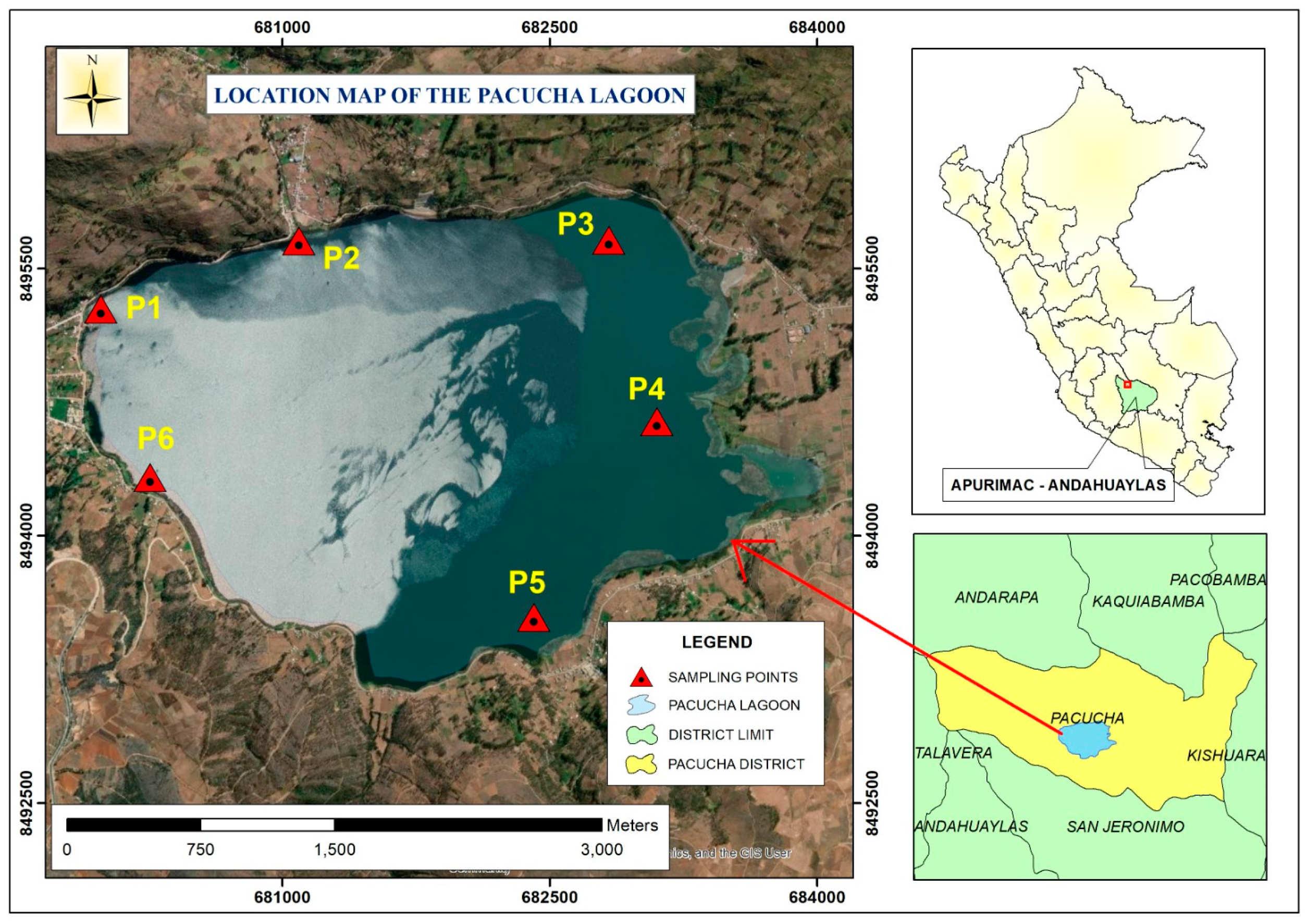
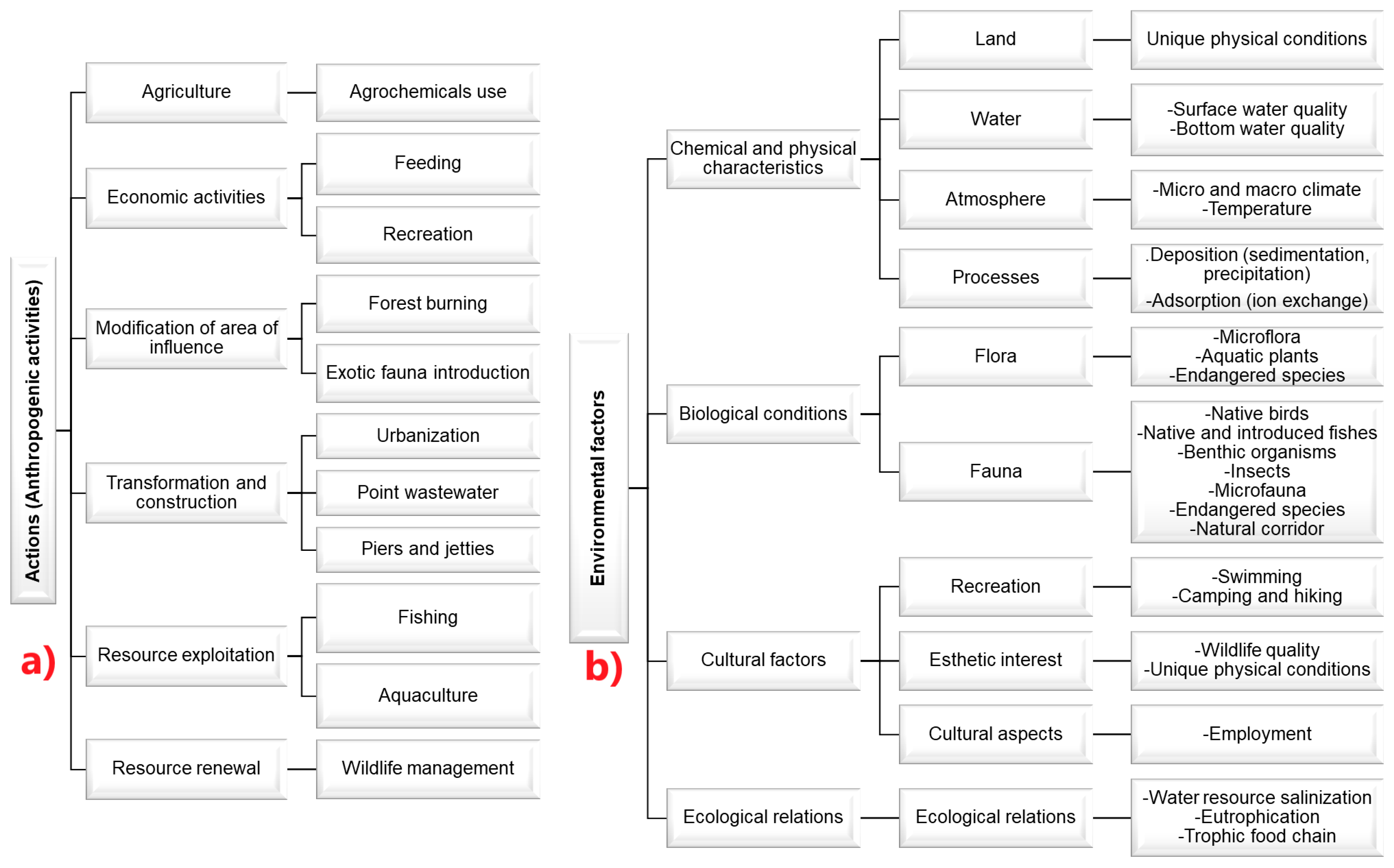
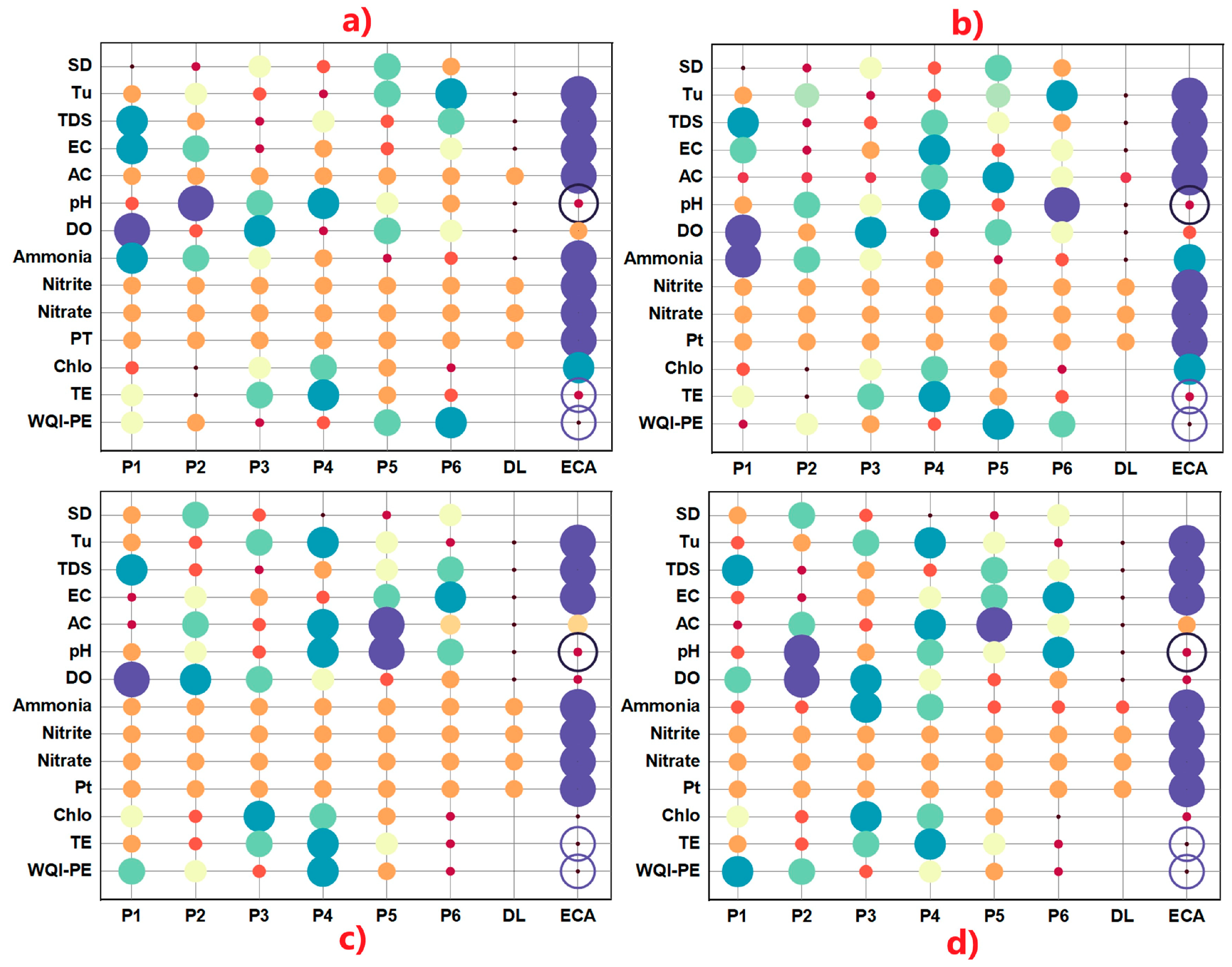
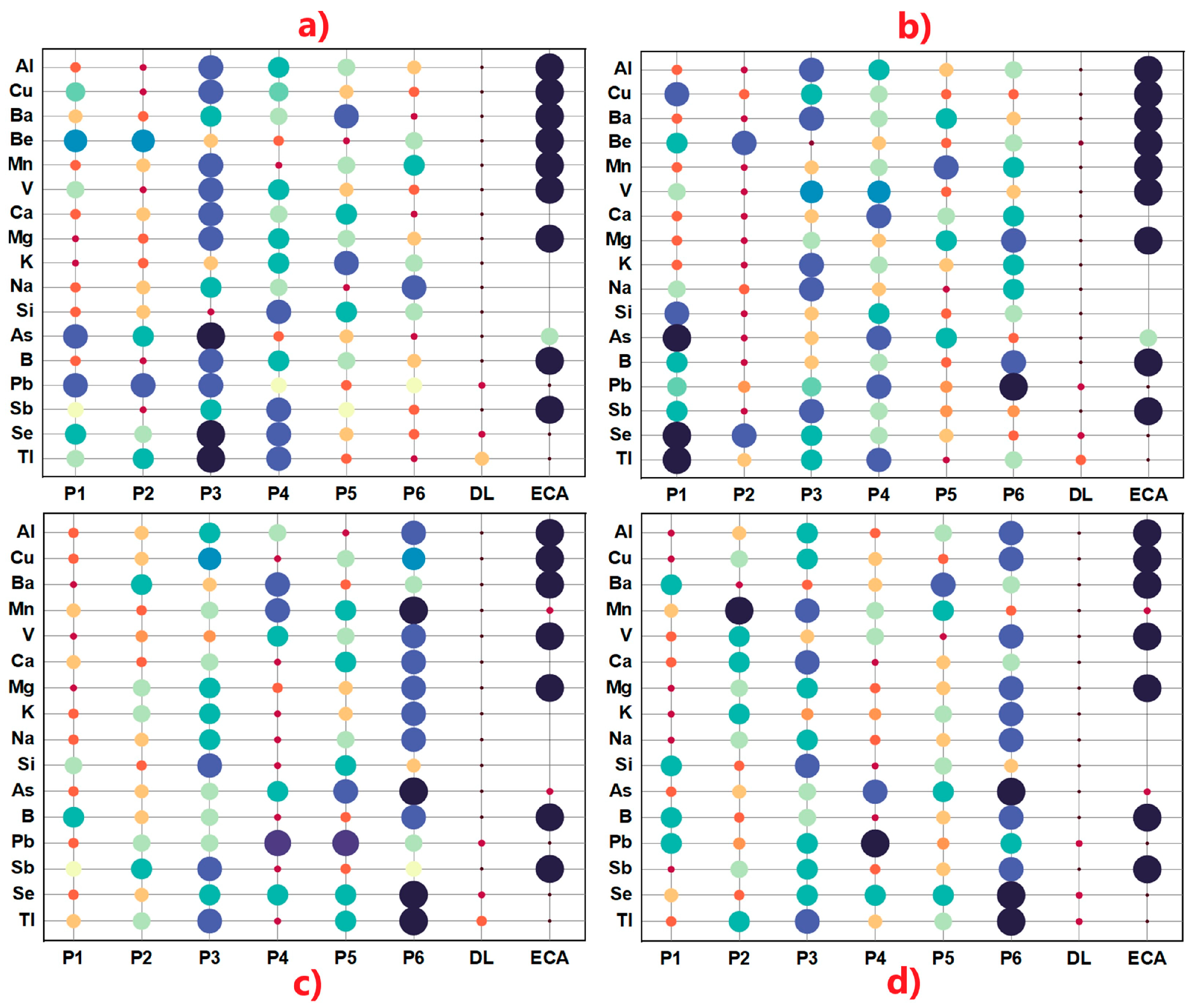
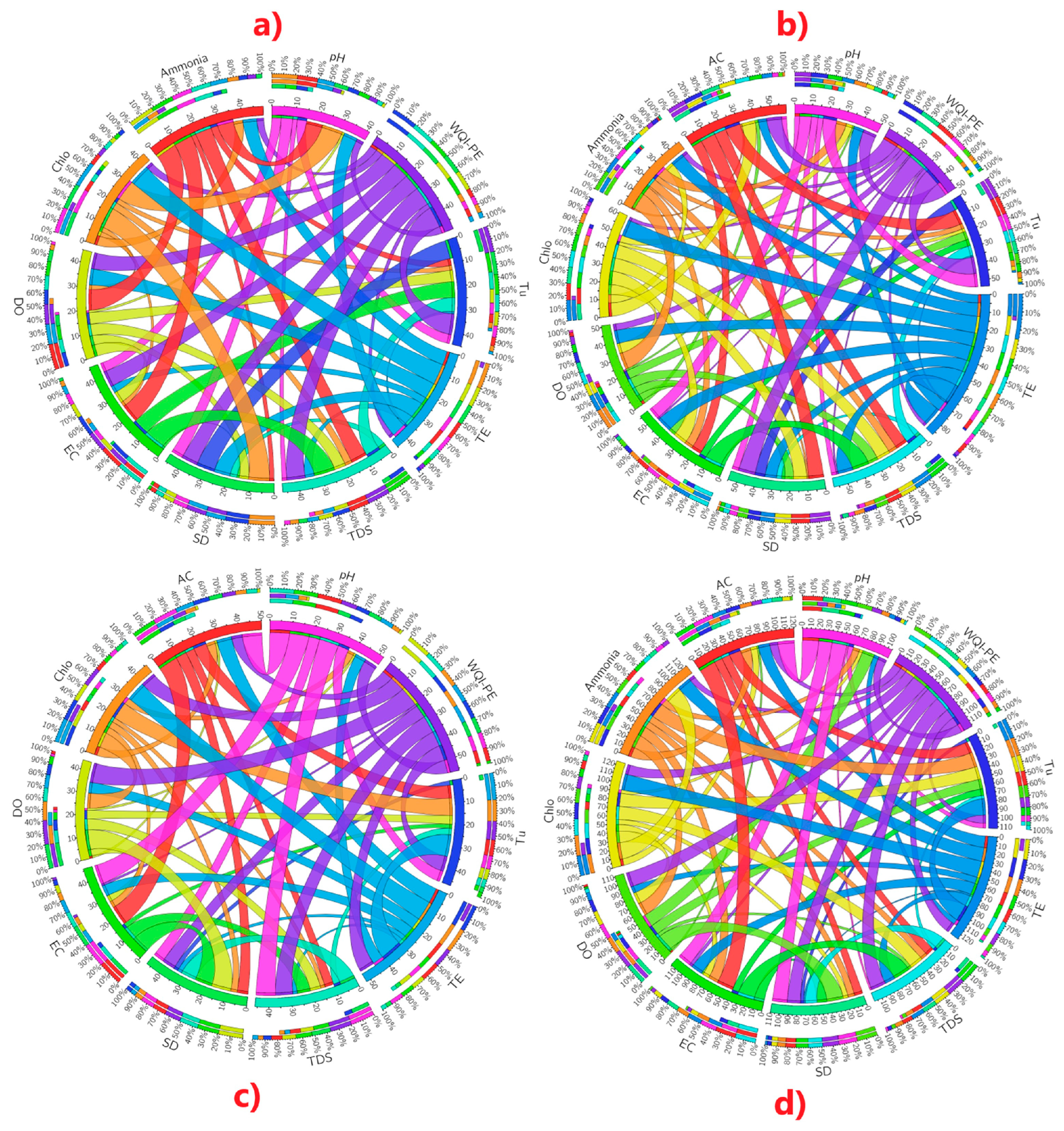


| Sampling Point | Location | Description | |
|---|---|---|---|
| Latitude | Longitude | ||
| P1 | −13.605659 | −73.336368 | Near the pier, 40 m from the shore. Recreation area. |
| P2 | −13.602117 | −73.326125 | Near the floodgate (mouth). At 50 m distance. Zone of cattails and native birds |
| P3 | −13.601978 | −73.310059 | 200 m from the shore. Anccopaccha sector. Zone of cattails and native birds |
| P4 | −13.611165 | −73.307517 | 100 m from the tributary—Río Argama. Tawantinsuyo sector. Muddy area, presence of pariguanas and birds of the area, low density of cattails. |
| P5 | −13.621129 | −73.31381 | At 300 m from the shore. Cultivation area, recreational activity, and grazing, low density of cattails. |
| P6 | 13.614175 | −73.333751 | 100 m from the shore. Virgen del Carmen Sector. This area features restaurants, high recreational activities, and relaxation, as well as a high density of cattails. |
| Parameter | Method | Equipment/Instrument | Place | Reference |
|---|---|---|---|---|
| Turbidity (Tu) | Nephelometric using a selective turbidity electrode | Portable multimeter model HQ40D, HACH (Loveland, CO, USA) | In field | 2130 B Standard Method [13]. |
| Electrical conductivity (EC) | Conductivity selective electrode | In field | 2520 B Standard Method [13]. | |
| Total Dissolved Solids (TDS) | Selective electrode | In field | User manual | |
| Transparency (SD) | Direct measurement | Secchi disk | In field | Visual measurement |
| Apparent color (AC) | Spectrophotometric at 456 nm | Tabletop photometer model HI83300-01, Hanna instruments (Woonsocket, RI, USA) | In laboratory | 2120 C-Standard Method [13]. |
| DO | Selective electrode | Portable multimeter model HQ40D, HACH | In field | 4500-O Standard Method [13]. |
| pH | Selective electrode | In field | 4500-H+ B Standard Method [13]. | |
| Nitrate | Spectrophotometric at 543 nm, by cadmium reduction. | UV-Vis Spectrophotometer, Model UV-1800, Shimadzu (Kyoto, Japan) | In laboratory | 4500-NO3 E, Standard Method [13] |
| Nitrite | Spectrophotometric at 534 nm, by formation of an azo dye. | In laboratory | 4500-NO2−, Standard Method [13] | |
| Ammonia | Spectrophotometric at 640 nm, reaction of ammonia, hypochlorite, and phenol catalyzed by sodium nitroprusside | In laboratory | 4500-NH3 F, Standard Method [13] | |
| Total phosphorus (PT) | Plasma ionization, with wavelengths | In laboratory | 4500-P E, Standard Method [13] | |
| Metal ions | Plasma ionization, with wavelengths for each metal ion, in radial mode, with R2 0.9998 | ICPE-OES, Model 9800, Shimadzu | In laboratory | 3120, Standard Method [13]. |
| WQI-PE | Qualification | Interpretation |
|---|---|---|
| 90–100 | Excellent | Water quality is free of threats or damage. Conditions are close to natural or desired levels. |
| 75–89 | Good | Water quality deviates slightly from its natural state; these desirable conditions may be subject to minor threats or damage. |
| 45–74 | Regular | Water quality is occasionally threatened or impaired; the quality deviates from desirable values. Most uses require treatment. |
| 30–44 | Bad | Water quality does not meet quality objectives, and desirable conditions are threatened or impaired; most uses require treatment. |
| 0–29 | Poor | Water quality does not meet quality objectives, and its quality is constantly threatened or impaired, and all uses require treatment. |
| State/Level | TE | SD (m) | PT (µg/L) | Chlo (µg/L) |
|---|---|---|---|---|
| Oligotrophic (TEav ≤ 30) | 0 | 64 | 0.75 | 0.04 |
| 10 | 32 | 1.5 | 0.12 | |
| 20 | 16 | 3 | 0.34 | |
| 30 | 8 | 6 | 0.94 | |
| Mesotrophic (30 < TEav ≤ 60) | 40 | 4 | 12 | 2.6 |
| 50 | 2 | 24 | 6.4 | |
| 60 | 1 | 48 | 20 | |
| Eutrophic (60 < TEav≤ 90) | 70 | 0.5 | 96 | 56 |
| 80 | 0.25 | 192 | 154 | |
| 90 | 0.12 | 384 | 427 | |
| Hypereutrophic (90 < TEav ≤ 100) | 100 | 0.062 | 768 | 1183 |
Disclaimer/Publisher’s Note: The statements, opinions and data contained in all publications are solely those of the individual author(s) and contributor(s) and not of MDPI and/or the editor(s). MDPI and/or the editor(s) disclaim responsibility for any injury to people or property resulting from any ideas, methods, instructions or products referred to in the content. |
© 2025 by the authors. Licensee MDPI, Basel, Switzerland. This article is an open access article distributed under the terms and conditions of the Creative Commons Attribution (CC BY) license (https://creativecommons.org/licenses/by/4.0/).
Share and Cite
Peralta-Guevara, D.E.; Quispe-Quispe, Y.; Palomino-Malpartida, Y.G.; Aronés-Medina, E.G.; Correa-Cuba, O.; Aróstegui León, E.; Carhuarupay-Molleda, Y.F.; Alzamora-Flores, H.; Licapa Redolfo, R.; Pumallihua Ramos, M.; et al. A High Andean Lake: A Current Look at Anthropogenic Activities and Water Quality. Water 2025, 17, 1182. https://doi.org/10.3390/w17081182
Peralta-Guevara DE, Quispe-Quispe Y, Palomino-Malpartida YG, Aronés-Medina EG, Correa-Cuba O, Aróstegui León E, Carhuarupay-Molleda YF, Alzamora-Flores H, Licapa Redolfo R, Pumallihua Ramos M, et al. A High Andean Lake: A Current Look at Anthropogenic Activities and Water Quality. Water. 2025; 17(8):1182. https://doi.org/10.3390/w17081182
Chicago/Turabian StylePeralta-Guevara, Diego E., Yadyra Quispe-Quispe, Ybar G. Palomino-Malpartida, Edgar G. Aronés-Medina, Odilon Correa-Cuba, Edward Aróstegui León, Yakov Felipe Carhuarupay-Molleda, Humberto Alzamora-Flores, Rolando Licapa Redolfo, Mawome Pumallihua Ramos, and et al. 2025. "A High Andean Lake: A Current Look at Anthropogenic Activities and Water Quality" Water 17, no. 8: 1182. https://doi.org/10.3390/w17081182
APA StylePeralta-Guevara, D. E., Quispe-Quispe, Y., Palomino-Malpartida, Y. G., Aronés-Medina, E. G., Correa-Cuba, O., Aróstegui León, E., Carhuarupay-Molleda, Y. F., Alzamora-Flores, H., Licapa Redolfo, R., Pumallihua Ramos, M., Tapia Tadeo, F., Huaraca Aparco, R., & Choque-Quispe, D. (2025). A High Andean Lake: A Current Look at Anthropogenic Activities and Water Quality. Water, 17(8), 1182. https://doi.org/10.3390/w17081182








